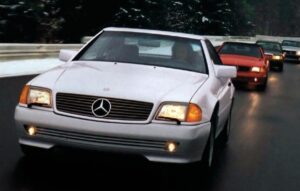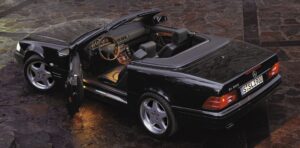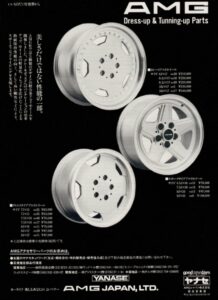The 1992 Mercedes SL: A year of innovation, luxury, and legacy
1. A look back at the 1992 Mercedes SL line-up
3. Price adjustments and technical tweaks
4. A changing of the guard at Mercedes
5. Overseas markets: SL around the world
6. Impeccable build and lasting legacy
A look back at the 1992 Mercedes SL line-up
The 1992 model year marked a notable chapter in the Mercedes legacy. Among the highlights was the long-awaited return of a four-seater convertible, introduced via the W124-based 300CE. Though it debuted at the 1991 Frankfurt Motor Show, actual production only began six months later—underscoring the carmaker’s commitment to precision and perfection.
Safety meets style
In September 1991, Mercedes revised the pricing of all domestic SL models, increasing them by €874. The bump, however, came with a silver lining: a driver’s side airbag became standard equipment. Dual airbags were now a relatively affordable €767, significantly lower than the prior optional price. Apart from this change and updated trim names, most options and their pricing remained untouched.
Compared to earlier versions, the six-cylinder models had gained 50 kg (110 lbs) in weight—interestingly distributed toward the rear on the 300SL and toward the front in the 24-valve version. The V8 saw a more modest 30 kg (66 lbs) increase, mostly affecting the front axle. Many speculated this could have been intentional—to make the upcoming V12 appear less bulky on paper, as there were no major spec changes to justify the added weight.
Price adjustments and technical tweaks
By February 1992, prices rose again, with the 300SL now priced at €55,512, the 300SL-24 at €59,176, and the range-topping 500SL at €78,182. Most optional features experienced only slight increases. Notably, the five-speed automatic gearbox became cheaper, dropping to €2,145, as did the official telephone kit. The previously listed radio/CD unit disappeared from the brochure, but the overall options list remained largely intact.
Behind the scenes, Mercedes engineers were busy refining mechanicals. Manual gearboxes (717.41, 717.43, and 717.44) received new grooved ball bearings to reduce noise and improve shifting. The V8’s prop shaft bearing setup was modified to lower NVH (noise, vibration, harshness), and similar tweaks were applied to the upcoming V12 models. In August 1992, automatic SLs got an updated vacuum unit for smoother pressure modulation.
A changing of the guard at Mercedes
1992 also saw leadership changes at the company. Dr. Dieter Zetsche (later to become the brand’s CEO) took over as Chief Engineer from Dr. Wolfgang Peter, who was reassigned following delays and budget issues related to the W140 project. Meanwhile, Jürgen Hubbert assumed control of the passenger car division.
Overseas markets: SL around the world
In the United States, the 300SL’s price rose by €3,855 at the start of 1992, while the 500SL jumped by €4,410—justified by the inclusion of standard traction control. New options included a ten-disc CD changer for €1,103 and a mobile phone priced at €1,190. Despite these upgrades, U.S. sales slowed significantly that year, with fewer than 5,000 SLs sold. Interestingly, the 500SL outsold the 300SL nearly three to one.
In the UK, pricing held steady from late 1991. The entry-level SL was priced at €74,300, excluding extras. Options quickly inflated the total: automatic transmission added €1,074, metallic paint cost €1,027, air-conditioning €3,370, leather trim €1,515, heated seats €615, powered seats €1,395, and dual airbags a hefty €3,694. Even the rear seats came at €1,864, with a windblocker tacking on another €330. Compared with rivals like the V12 Jaguar XJ-S convertible or the Maserati 2.8 SE Spyder at €62,950, the SL was a serious investment.
Yet it was one high-profile buyer who truly turned heads: in February 1992, Princess Diana took delivery of a red 500SL—marking the first time a British royal had publicly chosen a foreign car. The press outcry was swift, and the vehicle was soon returned. Today, it resides in the Mercedes-Benz Museum in Stuttgart, where it continues to draw attention.
In Japan, the 500SL was priced at 16,310,000 yen for 1992, positioning it just below the flagship 600SEL but above the 560SEC. AMG-tuned variants exceeded 25,000,000 yen. Prices remained stable into 1993 and even began to fall in subsequent years. Meanwhile, Australians faced a premium of around €147,000 for the 500SL.
Impeccable build and lasting legacy
Despite its premium price tag, the SL’s build quality earned rave reviews. A MotorSport magazine test summed it up perfectly: “We simply could not spot a single flaw in the fit and finish of the plastics, woolly carpeting, leather and walnut employed. The total absence of rattles is also uncanny.” The same review praised the 300SL-24’s chassis for its safety and superb handling—“You can drive the SL hard for fun…”
By late 1992, the speculative market bubble had burst, and wait times shrank to just three months in the UK. Still, Mercedes’ 135 British dealers remained busy, a testament to the car’s enduring appeal.
Are you already a proud owner of a Mercedes R129? If so, check out our selection of parts for this car at the following link:
https://octoclassic.com/product-category/mercedes-benz/r129
Photos sources: pinterest.com











